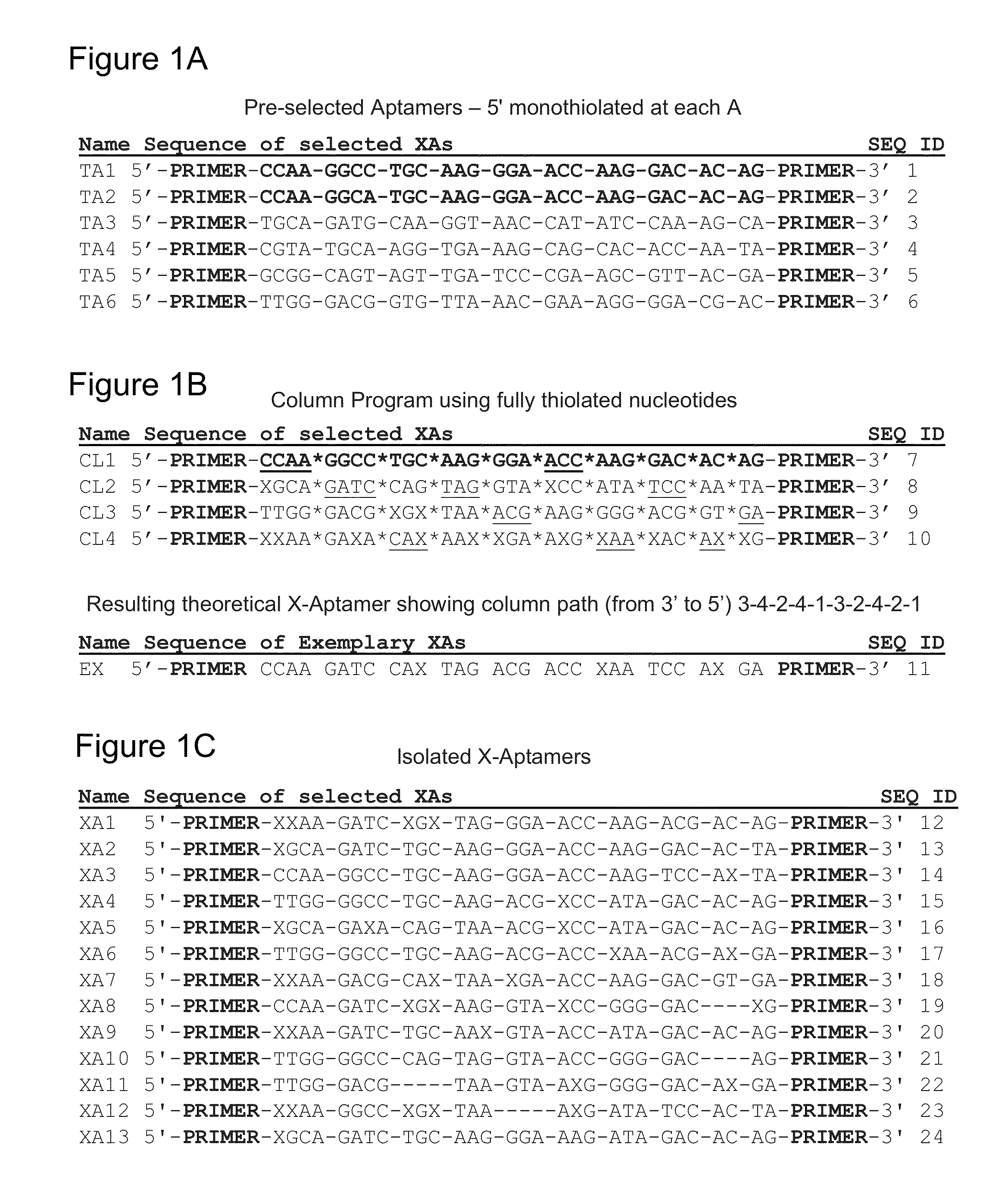Methods of x-aptamer generation and compositions thereof
- Summary
- Abstract
- Description
- Claims
- Application Information
AI Technical Summary
Benefits of technology
Problems solved by technology
Method used
Image
Examples
example 1
Complete Monothioate Backbone Substituted Aptamer to CD44-HABD
[0089]As one example of starting material, in a previous report, certain of the present inventors described thioaptamers substituted with monothiophosphates on the 5′ side of dA that bind to the hyaluronic acid binding domain of CD44 (CD44-HABD) (KD=187-295 nM). Somasunderam A et al. Biochemistry 49 (2010) 9106-9112. The sequences of the original preselected aptamers are shown in FIG. 1A. In the preselection, 6 sequences were isolated of which TA1 and TA2 (in bold) differed by a single nucleotide. Based on the primary sequence of several of these thioaptamers and observed variations, a pseudo-random, one-bead-one-sequence bead library of aptamers was synthesized using an automated four-column, split-pool synthesizer as described in Englhardt U.S. Pat. No. 7,576,037. FIG. 1B shows the sequences programmed into each of Columns 1-4 (CL1-4) of the synthesizer. Of these, CL1 was programmed to have the addition sequence of TA1,...
example 2
Second Generation X-Aptamers
[0125]Secondary structure predictions performed using MFold (Zuker, M. Nucleic Acids Research 31 (2003) 3406-3415) suggested that all selected XA sequences can form hairpin loop structures in which the random regions form loops and the primers form stem regions as shown in FIGS. 4A-C. Based on these predicted structures, several binding motifs and smaller constructs of various stem-loop regions were identified. The sequences of these truncated XA-sequences are shown below in Table 3. Such truncation allows elimination of excessive X moieties if desired while keeping the ligand binding domain.
TABLE 3SEQUENCES OF TRUNCATED X-APTAMERSMotifMotif SequenceSEQ IDCL.171 (XA2)272 (XA1)283 (XA4)294 (XA9)305 (XA5)31Alternating shading corresponds to the split-pool sequence sections in Fig. 1B for these aligned sequences.Following each motif number in column 1 above is the name of the parent aptamer of Fig. 1C from which the truncation was derived
[0126]The equilibriu...
example 3
[0135]In another embodiment, libraries are constructed using click chemistry as an alternative to the amide coupling chemistry to introduce multiple, in silico selected, drug-like hits into the X-aptamers. Click chemistry is used to describe two step chemical reactions that involve copper-catalyzed triazole formation from an azide and an alkyne as shown in FIG. 8. As shown, the azides (R—N3) react with alkynes under copper catalysis to form triazoles by cycloaddition. The azide and alkyne moieties can be used interchangeably and either one can be used to tag the molecule of interest, with the other used for subsequent detection. The azides and alkynes are biologically unique, inert, stable, and extremely small and can be used to tag nucleotides, which remain acceptable substrates for the enzymes. X-aptamers have also been chemically synthesized to contain 5-ethynyl-dU, which, when reacted with X-azides, forms a triazole appended to the X-aptamer at the 5-X-dU residue....
PUM
| Property | Measurement | Unit |
|---|---|---|
| Composition | aaaaa | aaaaa |
Abstract
Description
Claims
Application Information
 Login to View More
Login to View More - R&D
- Intellectual Property
- Life Sciences
- Materials
- Tech Scout
- Unparalleled Data Quality
- Higher Quality Content
- 60% Fewer Hallucinations
Browse by: Latest US Patents, China's latest patents, Technical Efficacy Thesaurus, Application Domain, Technology Topic, Popular Technical Reports.
© 2025 PatSnap. All rights reserved.Legal|Privacy policy|Modern Slavery Act Transparency Statement|Sitemap|About US| Contact US: help@patsnap.com



